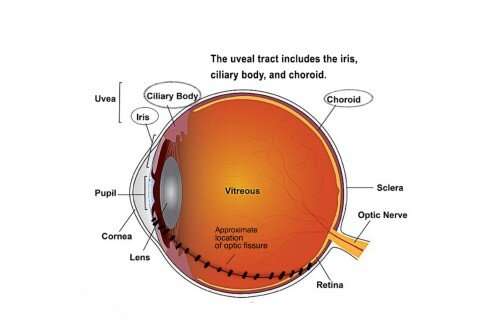This article has been reviewed according to Science X's editorial process and policies. Editors have highlighted the following attributes while ensuring the content's credibility:
fact-checked
trusted source
proofread
Zebrafish model helps explain eye development

Scientists at the National Eye Institute (NEI) have developed a zebrafish model of NEDBEH—a rare genetic disorder that can cause coloboma, where parts of the eye are missing due to developmental defects. The model provides a new tool for understanding the eye's embryonic development. The NEI is part of the National Institutes of Health.
"Despite advances in genetics, the underlying cause of coloboma in most families remains unclear," said Brian Brooks, M.D., Ph.D., chief of the NEI Ophthalmic Genetics and Visual Function Branch. The ongoing mystery is partly due to the myriad genes that must be turned on and off at pivotal moments for the eye's normal development.
Coloboma results from a failure of a transient structure called the optic fissure to close as the eye forms. To better understand coloboma, Brooks and NEI Scientists Aman George, Ph.D., explored NEDBEH-associated gene RERE. NEDBEH is short for neurodevelopmental disorder with or without anomalies of the brain, eye, and heart. The RERE gene produces a scaffold-like protein (rere) that enables assembly of transcriptional regulators—proteins that activate or deactivate gene expression.
Brooks and George characterized early eye development in zebrafish with a mutation in the gene rerea—the zebrafish equivalent of the human RERE gene. Compared with normal zebrafish, mutants showed eye defects including enlarged optic stalks, eye tissue in the brain, and coloboma. The optic stalk is a transient eye structure that connects the eye to the brain.
The rerea mutation altered the expression of key developmental genes. Of note, the rerea mutation interfered with signaling of sonic hedgehog (shh), an important protein that directs the development of a variety of organs and tissue, including the optic stalk and retina. By inhibiting the shh pathway at a different point, the scientists rescued coloboma, leading to proper closure of the optic fissure.
"Our zebrafish model helps clarify the role of the RERE gene in eye development," said George. "Identifying appropriate model systems for studying coloboma is essential to understanding its underlying mechanisms and finding targets for rescuing defects."
The research is published in the journal Developmental Dynamics.
More information: Aman George et al, Zebrafish model of RERE syndrome recapitulates key ophthalmic defects that are rescued by small molecule inhibitor of shh signaling, Developmental Dynamics (2022). DOI: 10.1002/dvdy.561


















